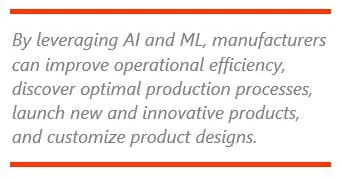

Keywords: Artificial Intelligence (AI), Machine Learning (ML), Automation, Generative Design, Advanced Analytics, Autonomous Systems, Digital Twin, Training Algorithms, Cognitive Manufacturing, ARC Advisory Group.
The fully autonomous factory has always been an elusive vison that represents the culmination of the evolution of production automation. It is a manufacturing environment that is completely unmanned and run by AI systems directing machines and robotic production cells and lines. While this vision may become reality at some point in the future, it is unlikely that AI will fully enable this vision in the near term. However, it is clear that AI is already having and will continue to have a profound effect on manufacturing processes and the current smart manufacturing environment.
The fundamental tenets of today’s AI and ML were developed and established decades ago. Neural networks, cognitive computing, inference engines, deep learning, and self-organizing algorithms that give AI much of the power it has today have been established and evolving for some time. The advancement of computing processors and the overall power of today’s computing resources is enabling the actual application of AI technology and the current renaissance that industry, business, and society at large is experiencing with intelligent systems. One of the primary benefits of AI is helping creative people be more creative and do more. AI does not necessarily replace people, but the better applications enable humans to do what they’re uniquely good at even better. In manufacturing that could be designing and building better parts and products and improving the processes that make them in the factory.
Currently, most of the AI employed in manufacturing is involved with parts inspection, metrology, measurement, nondestructive testing (NDT), and other quality assurance processes. While AI is an integral component in product design (generative design) today, fabrication and assembly is still in its initial stages. Machine tools and other production equipment are just beginning to become smarter in terms of condition monitoring and predictive maintenance powered by AI. While the bulk of production machinery and equipment is not considered “smart” today, that will undoubtedly change in the near future as AI becomes more pervasive in factories and production environments.
A smart manufacturing environment is centered on factories that use intelligent, connected production equipment and devices that allow for data-driven decision-making to optimize processes and productivity across the product lifecycle. Initially, manufacturers introduced the use of advanced analytics that allowed production systems to progress from condition monitoring to predictive and  prescriptive analytics. The idea was that this would create a pathway from connected and intelligent to AI enabled self-aware machines and production equipment and ultimately lead to autonomous self-healing systems.
prescriptive analytics. The idea was that this would create a pathway from connected and intelligent to AI enabled self-aware machines and production equipment and ultimately lead to autonomous self-healing systems.
Manufacturing engineers and factory managers soon realized that manufacturing data is a good fit for AI and especially ML is a natural source of analytical data, which is easier for machines to analyze. Hundreds of variables impact the production process, and while these are very hard to analyze for humans, ML models can easily predict the impact of individual variables in such complex situations. By leveraging AI and ML, manufacturers can improve operational efficiency, discover optimal production processes, launch new and innovative products, customize product designs, and plan future financial actions to progress on their digital transformation.
As AI is applied to manufacturing it is making much more accurate manufacturing process design decisions, including potential problem diagnosis and resolution when inconsistencies crop up in the fabrication process by using a digital twin. While half of a digital twin is a virtual representation of the physical part as designed, it is much more than just a CAD model. This virtual replica also represents the physical side of the digital twin as the machine tool, robotic work cells, and other production equipment. It is from the physical operations side of the digital twin that the data is generated that enables the AI to make optimal decisions on the production process.
While virtual models are conceptual in nature, the real-time and operational data is a digital representation of real physical events. CAD models represent the virtual fit, form, and function of the digital twin’s physical counterpart. However, real-time operational and asset data are required to execute analytics applications that define the state and behavior of the performance-based digital twin and allow optimization and process improvement.
ARC Advisory Group clients can view the complete report at the ARC Client Portal.
Please Contact Us if you would like to speak with the author.
Obtain more ARC In-depth Research at Market Analysis

